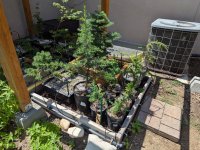jevanlewis
Mame
There are several good threads on this topic already, which helped inform my eventual solution. Because of a vacation this summer, I am asking a friend to water my trees. However, as a backup, I wanted to have an automatic watering system. All my trees are pre-bonsai: 4 are in Anderson Flats; 6 are in 10" colanders, each of which is in an Anderson Flat full of pure lava rock (acting as a sort of grow bed); and 2 are in small rectangular bonsai training pots.
High-level solution
My landscape irrigation system has a zone that covers the flower beds where my bonsai are. So, my plan was to build a system directly off the line that feeds one of the sprinkler heads; for emitters, I decided to use spot spitters. I built the system on the ground since my trees aren't currently on a bench.
Detailed solution
System components (in order of flow of water; doesn't include pipe converters, elbows, etc.):
1) Polyethylene tube (2") <-- previously fed a single sprinkler head
2) Shut off value
3) Pressure regulator (25 psi) + filter
5) Polyethylene tube (3")
4) Air vent and vacuum relief valve
6) Polyethylene tube (3")
7) Spaghetti tubing (1/8")
8) Spot spitters
For each Anderson Flat, I used two of the tall dark green (downward facing) spitters; I needed two per pot to ensure full coverage of the soil. I used the longer spitters because the shorter spitters didn't go deep enough in the soil to stay firmly in place, since the outer edges of the pots are pure medium (i.e., no roots) consisting of pumice and lava, which is very loose.
Results and learnings
The system distributes water to all sections of each bonsai pot in less than 5 mins. I like the precision the system provides; however, I also like the simplicity and resilience of a system like @Brian Van Fleet (link). Specifically, he can pretty much move and arrange his trees anywhere under the spray pattern without needing to reconfigure spaghetti tubing and emitters. Also, my system is much more susceptible to risk from things like emitters getting dislodged by wind, people or animals. Regardless, my system should serve as a great backup solution for vacations or when I'm in the office and my family members aren't available to water for me. I'll probably put up a security camera to provide visual confirmation that it is working.
Photos
Full system system

2" poly tube feeder line and valve box
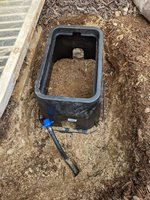
Valve box with shutoff valve and pressure regulator/filter combo
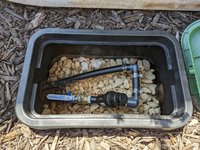
Air vent and vacuum relief valve
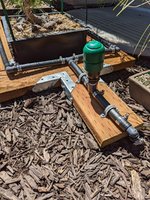
Poly tube, spaghetti tube, and spitters

System in operation
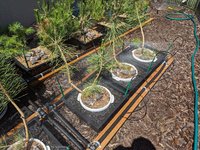
High-level solution
My landscape irrigation system has a zone that covers the flower beds where my bonsai are. So, my plan was to build a system directly off the line that feeds one of the sprinkler heads; for emitters, I decided to use spot spitters. I built the system on the ground since my trees aren't currently on a bench.
Detailed solution
System components (in order of flow of water; doesn't include pipe converters, elbows, etc.):
1) Polyethylene tube (2") <-- previously fed a single sprinkler head
2) Shut off value
3) Pressure regulator (25 psi) + filter
5) Polyethylene tube (3")
4) Air vent and vacuum relief valve
6) Polyethylene tube (3")
7) Spaghetti tubing (1/8")
8) Spot spitters
For each Anderson Flat, I used two of the tall dark green (downward facing) spitters; I needed two per pot to ensure full coverage of the soil. I used the longer spitters because the shorter spitters didn't go deep enough in the soil to stay firmly in place, since the outer edges of the pots are pure medium (i.e., no roots) consisting of pumice and lava, which is very loose.
Results and learnings
The system distributes water to all sections of each bonsai pot in less than 5 mins. I like the precision the system provides; however, I also like the simplicity and resilience of a system like @Brian Van Fleet (link). Specifically, he can pretty much move and arrange his trees anywhere under the spray pattern without needing to reconfigure spaghetti tubing and emitters. Also, my system is much more susceptible to risk from things like emitters getting dislodged by wind, people or animals. Regardless, my system should serve as a great backup solution for vacations or when I'm in the office and my family members aren't available to water for me. I'll probably put up a security camera to provide visual confirmation that it is working.
Photos
Full system system

2" poly tube feeder line and valve box

Valve box with shutoff valve and pressure regulator/filter combo

Air vent and vacuum relief valve

Poly tube, spaghetti tube, and spitters

System in operation






